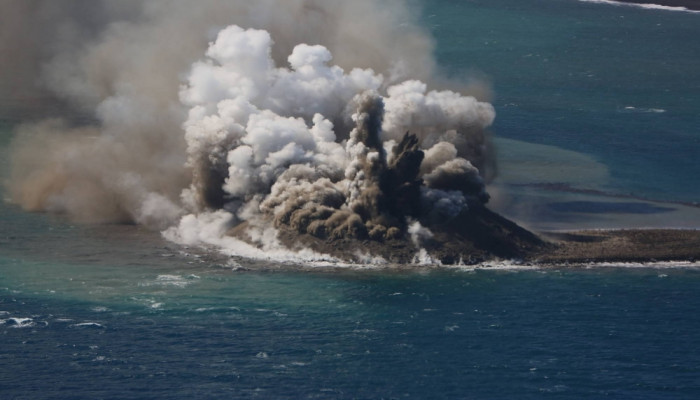New Island surfaces as submarine volcano erupts to the South of Tokyo
- In Reports
- 05:46 PM, Nov 07, 2023
- Myind Staff
A recent undersea volcanic eruption has given rise to a new island off the coast of Iwo Jima, situated approximately 1,200 kilometers south of Tokyo. This newly formed island is a part of the Ogasawara Islands and primarily consists of rock masses that emerged to the north of the eruption site. There is potential for further growth if volcanic activity persists, as confirmed by the Earthquake Research Institute at the University of Tokyo.
The eruption, characterized as a phreatomagmatic eruption, has been consistently expelling magma underwater in the vicinity of Iwo Jima. This magma has been cooling and solidifying beneath the water's surface. However, following an eruption on October 30, the accumulated solidified magma began to breach the water's surface, resulting in the formation of the new island. Professor Emeritus of Volcanology at the University of Tokyo, Setsuya Nakada, personally observed this transformation during a flyover of the site.
“In an earlier stage, a vertical jet of black colour, debris — which is a solidified magma — and water gushed upward,” Nakada said. “Since Nov. 3, the eruption started changing and the emission of volcanic ash continued explosively.”
The newly formed isle is primarily composed of pumice, a material that is susceptible to erosion. However, the likelihood of the isle's long-term existence remains favourable as long as volcanic activity persists. This is because the ongoing lava flow will play a protective role in safeguarding the isle, according to Nakada.
“The areas that don't have lava could be scraped away. So if more and more lava comes out, and covers the area, I think that part will remain forever,” Nakada said, adding that it remains uncertain whether the eruption will continue.
Nakada pointed out that the manner in which the new island emerged is reminiscent of the process that led to the formation of another island in 2013. This island eventually fused with Nishinoshima, an island situated within the Ogasawara chain. Nishinoshima itself originated from an underwater volcanic eruption, gradually expanding to reach a diameter of approximately 2 kilometers.
“There is a possibility that the (new) island could merge with Iwo Jima if the eruption continues,” Nakada said.
According to the Japanese Meteorological Agency, Iwo Jima has been experiencing volcanic tremors at regular intervals since approximately October 21. These tremors have been accompanied by eruptions occurring off the island's southern coast. Iwo Jima is an active volcano located to the south of Ogasawara Island and is situated approximately 60 kilometers north of the Fukutoku-Okanoba underwater volcano, which had a significant undersea eruption in 2021.
In July 2022, a notable magmatic eruption was documented for the first time off the southeastern coast of Iwo Jima, alongside a phreatomagmatic eruption. Subsequently, there were additional eruptions in June and October, marking a series of volcanic activities in the region. The ongoing seismic and eruptive events around Iwo Jima raise concerns about the volcanic activity in this area, necessitating close monitoring and research by experts and authorities.
Image source: Japan Times







Comments